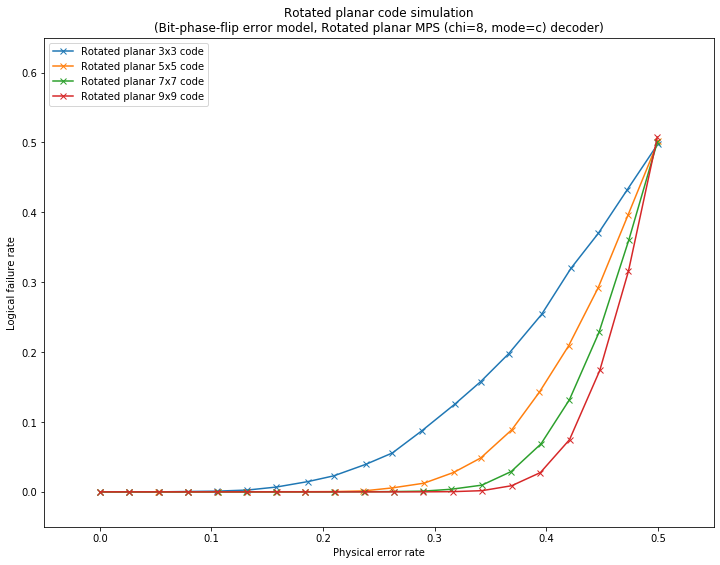qecsim demos¶
Plotting logical failure rate as a function of physical error rate for rotated planar stabilizer codes¶
This demo shows how to plot statistics on many error correction simulation runs, see figure for more details.
The code makes use of
qecsim.app.run(code, error_model, decoder, error_probability, max_runs, max_failures).
Initialise run parameters¶
%matplotlib inline
import collections
import itertools
import numpy as np
import matplotlib.pyplot as plt
from qecsim import app
from qecsim.models.generic import BitPhaseFlipErrorModel
from qecsim.models.rotatedplanar import RotatedPlanarCode, RotatedPlanarMPSDecoder
# set models
codes = [RotatedPlanarCode(*size) for size in [(3, 3), (5, 5), (7, 7), (9, 9)]]
error_model = BitPhaseFlipErrorModel()
decoder = RotatedPlanarMPSDecoder(chi=8)
# set physical error probabilities
error_probability_min, error_probability_max = 0, 0.5
error_probabilities = np.linspace(error_probability_min, error_probability_max, 20)
# set max_runs for each probability
max_runs = 10000
# print run parameters
print('Codes:', [code.label for code in codes])
print('Error model:', error_model.label)
print('Decoder:', decoder.label)
print('Error probabilities:', error_probabilities)
print('Maximum runs:', max_runs)
Codes: ['Rotated planar 3x3', 'Rotated planar 5x5', 'Rotated planar 7x7', 'Rotated planar 9x9']
Error model: Bit-phase-flip
Decoder: Rotated planar MPS (chi=8, mode=c)
Error probabilities: [0. 0.02631579 0.05263158 0.07894737 0.10526316 0.13157895
0.15789474 0.18421053 0.21052632 0.23684211 0.26315789 0.28947368
0.31578947 0.34210526 0.36842105 0.39473684 0.42105263 0.44736842
0.47368421 0.5 ]
Maximum runs: 10000
Run simulations¶
# run simulations and print data from middle run to view format
data = [app.run(code, error_model, decoder, error_probability, max_runs=max_runs)
for code in codes for error_probability in error_probabilities]
print(data[len(data)//2])
{'code': 'Rotated planar 7x7', 'n_k_d': (49, 1, 7), 'time_steps': 1, 'error_model': 'Bit-phase-flip', 'decoder': 'Rotated planar MPS (chi=8, mode=c)', 'error_probability': 0.0, 'measurement_error_probability': 0.0, 'n_run': 10000, 'n_success': 10000, 'n_fail': 0, 'error_weight_total': 0, 'error_weight_pvar': 0, 'logical_failure_rate': 0.0, 'physical_error_rate': 0.0, 'wall_time': 623.0377811500002}
Prepare data for plotting¶
# prepare code to x,y map and print
code_to_xys = {}
for run in data:
xys = code_to_xys.setdefault(run['code'], [])
xys.append((run['physical_error_rate'], run['logical_failure_rate']))
print('\n'.join('{}: {}'.format(k, v) for k, v in code_to_xys.items()))
Rotated planar 3x3: [(0.0, 0.0), (0.02652222222222222, 0.0), (0.05328888888888889, 0.0), (0.07881111111111111, 0.0005), (0.10457777777777778, 0.001), (0.13224444444444444, 0.0026), (0.1578, 0.0068), (0.18645555555555557, 0.0147), (0.20952222222222222, 0.0229), (0.23814444444444444, 0.0393), (0.2620444444444444, 0.0556), (0.2882777777777778, 0.0871), (0.3180555555555556, 0.1255), (0.3412777777777778, 0.1578), (0.3663888888888889, 0.1978), (0.39576666666666666, 0.2538), (0.4221333333333333, 0.3199), (0.4466666666666667, 0.37), (0.4727, 0.4326), (0.4997888888888889, 0.4973)]
Rotated planar 5x5: [(0.0, 0.0), (0.025936, 0.0), (0.052516, 0.0), (0.079112, 0.0), (0.10588399999999999, 0.0), (0.131896, 0.0), (0.15755999999999998, 0.0002), (0.183908, 0.0002), (0.210472, 0.0004), (0.235948, 0.0013), (0.261804, 0.0056), (0.29042399999999996, 0.0124), (0.31702800000000003, 0.0278), (0.34118000000000004, 0.0484), (0.369148, 0.0889), (0.393752, 0.1425), (0.41991999999999996, 0.2087), (0.44654799999999994, 0.2922), (0.47332399999999997, 0.3963), (0.500432, 0.5025)]
Rotated planar 7x7: [(0.0, 0.0), (0.026026530612244896, 0.0), (0.05289591836734694, 0.0), (0.07898163265306123, 0.0), (0.10591020408163265, 0.0), (0.1312795918367347, 0.0), (0.15808979591836736, 0.0), (0.18390204081632652, 0.0), (0.20982857142857142, 0.0), (0.23698775510204081, 0.0001), (0.26319387755102036, 0.0004), (0.2891591836734694, 0.001), (0.3147204081632653, 0.0037), (0.3422734693877551, 0.0096), (0.36848571428571425, 0.029), (0.3953061224489796, 0.0687), (0.4207714285714285, 0.1319), (0.447238775510204, 0.2282), (0.47406122448979593, 0.3609), (0.49954897959183675, 0.5006)]
Rotated planar 9x9: [(0.0, 0.0), (0.026504938271604935, 0.0), (0.052658024691358024, 0.0), (0.07902962962962963, 0.0), (0.10498765432098764, 0.0), (0.13198395061728396, 0.0), (0.15845061728395063, 0.0), (0.18364444444444444, 0.0), (0.2106864197530864, 0.0), (0.23753333333333335, 0.0), (0.26357901234567904, 0.0), (0.2892901234567901, 0.0), (0.31629753086419754, 0.0003), (0.3424358024691358, 0.0017), (0.36902345679012344, 0.0088), (0.3947320987654321, 0.0276), (0.42084691358024695, 0.0747), (0.44793456790123454, 0.1737), (0.47360740740740737, 0.3156), (0.49949135802469136, 0.5076)]
Plot logical failure rate against physical error rate¶
# format plot
fig = plt.figure(1, figsize=(12, 9))
plt.title('Rotated planar code simulation\n({} error model, {} decoder)'.format(error_model.label, decoder.label))
plt.xlabel('Physical error rate')
plt.ylabel('Logical failure rate')
plt.xlim(error_probability_min-0.05, error_probability_max+0.05)
plt.ylim(-0.05, 0.65)
# add data
for code, xys in code_to_xys.items():
plt.plot(*zip(*xys), 'x-', label='{} code'.format(code))
plt.legend(loc='upper left')
plt.show()

Fig. 1. Logical failure rate as a function of physical error rate for rotated planar stabilizer codes.
Definitions:
- A physical error occurs when the generated error acts non-trivially on a physical qubit.\((\text{physical error rate}) = mean(\text{error weight}) / (\text{number of physical qubits})\).
- A logical failure occurs when the combined action of the generated error and recovery operation acts non-trivially on the codespace, irrespective of the number of logical qubits encoded.\((\text{logical failure rate}) = (\text{number of logical failures}) / (\text{number of runs})\).